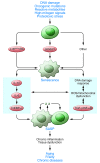Cellular senescence and the senescent secretory phenotype: therapeutic opportunities
- PMID: 23454759
- PMCID: PMC3582125
- DOI: 10.1172/JCI64098
Cellular senescence and the senescent secretory phenotype: therapeutic opportunities
Abstract
Aging is the largest risk factor for most chronic diseases, which account for the majority of morbidity and health care expenditures in developed nations. New findings suggest that aging is a modifiable risk factor, and it may be feasible to delay age-related diseases as a group by modulating fundamental aging mechanisms. One such mechanism is cellular senescence, which can cause chronic inflammation through the senescence-associated secretory phenotype (SASP). We review the mechanisms that induce senescence and the SASP, their associations with chronic disease and frailty, therapeutic opportunities based on targeting senescent cells and the SASP, and potential paths to developing clinical interventions.
Figures



Similar articles
-
The Emerging Role of Senescence in Ocular Disease.Oxid Med Cell Longev. 2020 Mar 9;2020:2583601. doi: 10.1155/2020/2583601. eCollection 2020. Oxid Med Cell Longev. 2020. PMID: 32215170 Free PMC article. Review.
-
Senolytics and Senostatics: A Two-Pronged Approach to Target Cellular Senescence for Delaying Aging and Age-Related Diseases.Mol Cells. 2019 Dec 31;42(12):821-827. doi: 10.14348/molcells.2019.0298. Mol Cells. 2019. PMID: 31838837 Free PMC article. Review.
-
New Horizons: Novel Approaches to Enhance Healthspan Through Targeting Cellular Senescence and Related Aging Mechanisms.J Clin Endocrinol Metab. 2021 Mar 8;106(3):e1481-e1487. doi: 10.1210/clinem/dgaa728. J Clin Endocrinol Metab. 2021. PMID: 33155651 Free PMC article. Review.
-
Senescence and the SASP: many therapeutic avenues.Genes Dev. 2020 Dec 1;34(23-24):1565-1576. doi: 10.1101/gad.343129.120. Genes Dev. 2020. PMID: 33262144 Free PMC article. Review.
-
Targeting senescent cells: approaches, opportunities, challenges.Aging (Albany NY). 2019 Nov 30;11(24):12844-12861. doi: 10.18632/aging.102557. Epub 2019 Nov 30. Aging (Albany NY). 2019. PMID: 31789602 Free PMC article. Review.
Cited by
-
Upregulation of PD-L1 in Senescence and Aging.Mol Cell Biol. 2022 Oct 20;42(10):e0017122. doi: 10.1128/mcb.00171-22. Epub 2022 Sep 26. Mol Cell Biol. 2022. PMID: 36154662 Free PMC article.
-
Mutant lamin A links prophase to a p53 independent senescence program.Cell Cycle. 2015 Aug 3;14(15):2408-21. doi: 10.1080/15384101.2015.1053671. Epub 2015 Jun 1. Cell Cycle. 2015. PMID: 26029982 Free PMC article.
-
Role of the BrafV637E mutation in hepatocarcinogenesis induced by treatment with diethylnitrosamine in neonatal B6C3F1 mice.Mol Carcinog. 2017 Feb;56(2):478-488. doi: 10.1002/mc.22510. Epub 2016 Jun 10. Mol Carcinog. 2017. PMID: 27253992 Free PMC article.
-
Multiple facets of p53 in senescence induction and maintenance.Cancer Sci. 2016 Nov;107(11):1550-1555. doi: 10.1111/cas.13060. Epub 2016 Nov 4. Cancer Sci. 2016. PMID: 27560979 Free PMC article. Review.
-
Factor XII signaling via uPAR-integrin β1 axis promotes tubular senescence in diabetic kidney disease.Nat Commun. 2024 Sep 11;15(1):7963. doi: 10.1038/s41467-024-52214-8. Nat Commun. 2024. PMID: 39261453 Free PMC article.
References
-
- [No authors listed]. The Silver Book: Chronic Disease and Medical Innovation in an Aging Nation. Washington, DC, USA: Alliance for Aging Research; 2012.
-
- Tuomisto K, Jousilahti P, Sundvall J, Pajunen P, Salomaa V. C-reactive protein, interleukin-6 and tumor necrosis factor alpha as predictors of incident coronary and cardiovascular events and total mortality. A population-based, prospective study. Thromb Haemost. 2006;95(3):511–518. - PubMed
Publication types
MeSH terms
Substances
Grants and funding
LinkOut - more resources
Full Text Sources
Other Literature Sources
Medical

